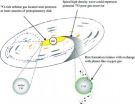(Press-News.org) Old Westbury, New York (Mar. 3, 2011) – Fossil records verify a long-standing theory that horses evolved through natural selection, according to groundbreaking research by two anatomy professors at New York College of Osteopathic Medicine (NYCOM) of New York Institute of Technology.
Working with colleagues from Massachusetts and Spain, Matthew Mihlbachler, Ph.D., and Nikos Solounias, Ph.D. arrived at the conclusion after examining the teeth of 6,500 fossil horses representing 222 different populations of more than 70 extinct horse species. The records, spanning the past 55 million years, indicate a "critical" lag time between the evolution of horse teeth and dietary changes resulting from climate change. The breakthrough findings were chosen for publication in the March 4 issue of the prestigious bi-weekly international journal Science.
"One of the advantages of studying extinct creatures like prehistoric horses is we can look at how animals responded to their environments over millions of years—something that biologists who study living species cannot do," Mihlbachler said, adding that the biggest surprise of the study was that while some of the extinct populations they examined had extremely abrasive diets, much of the time, it seemed horses had it surprisingly easy. This suggests that "strong natural selection" for different types of teeth only happened occasionally during brief intervals in horse history.
Solounias helped develop a methodology known as dental mesowear analysis to reconstruct the diets of extinct species by measuring food-related wear and tear on fossil teeth. He and Mihlbachler used the process to investigate wear patterns on the molars of thousands of fossil horses. They later analyzed their data alongside records of North American climate changes that would have shifted the animals' diets from rainforest fruits and woody, leafy vegetation to the more abrasive diets found in grasslands.
"Lag time in the evolution of horse teeth in comparison to dietary changes is critical," Mihlbachler explained. "We found that evolutionary changes in tooth anatomy lag behind the dietary changes by a million years or more."
While paleontologists have long held horses as classic examples of evolution through natural selection, the theory has been difficult to test because the majority of horse species are extinct. However, Mihlbachler and Solounias' observation that dental changes in horses follow their dietary changes is consistent with evolution due to adaptation.
"'You are what you eat': we hear this all the time, but now we know it is true," explained Thomas Scandalis, Dean of NYCOM. "This study shows that the evolutionary path of horses as we know them today was affected by the food available to their prehistoric ancestors."
The duo's research shows that not only has the number of horse species been greatly reduced in the past few million years, but also that the diets of horses have been narrowly restricted. "Living horses are anything but typical examples of the dietary ecology of this once great group of mammals," Solounias said.
###
The study is summarized in a paper titled "Dietary Change and Evolution of Horses in North America."
About NYIT
New York Institute of Technology (NYIT) offers undergraduate, graduate, and professional degrees in more than 90 fields of study, including architecture and design; arts and sciences; education; engineering and computing sciences; health professions; management; and osteopathic medicine. A non-profit independent, private institution of higher education, NYIT has more than 15,000 students attending campuses on Long Island and Manhattan, online, and at its global campuses. NYIT sponsors 11 NCAA Division II programs and one Division I team.
Led by President Edward Guiliano, NYIT is guided by its mission to provide career-oriented professional education, offer access to opportunity to all qualified students, and support applications-oriented research that benefits the larger world. To date, 85,000 graduates have received degrees from NYIT. For more information, visit nyit.edu.
END
Optics researchers from the Universities of Glasgow and Bristol have developed an iPad application for accurate, easy and intuitive use of optical tweezers.
Optical tweezers, used to manipulate tiny particles through the use of highly focused laser beams, are the tool at the heart of much molecular biology – helping us to experiment with and better understand the microscopic processes of organisms.
Research published today, Friday 4 March 2011, in IOP Publishing's Journal of Optics, shows how a team of researchers has overcome the limitations of computer mouse and ...
Johns Hopkins scientists have discovered that PARIS — the protein — facilitates the most common form of Parkinson's disease (PD), which affects about 1 million older Americans. The findings of their study, published March 4 in Cell, could lead to important new targets for treatment.
Previous research has shown that a protein dubbed parkin protects brain cells by "tagging" certain toxic elements for natural destruction. Mutations in the parkin gene cause rare forms of PD that run in families, but its role remained unclear in sporadic late-onset PD, the prevalence of which ...
Star-shaped cells in our brains called astrocytes were once considered little more than structures to fill the gaps between all-important neurons. But more recent evidence has emerged to reveal that those astrocytes play more than a supporting role; they are involved in information processing and signal transmission and they help to regulate the shapes of our neurons and their connections to one another.
Now, researchers reporting in the March 4th Cell, a Cell Press publication, have found that astrocytes are also essential for making long-term memories. When they don't ...
Scientists have performed a micro-probe analysis of the core and outer layers of a pea-sized piece of a meteorite some 4.57 billion years old to reconstruct the history of its formation, providing the first evidence that dust particles like this one experienced wildly varying environments during the planet-forming years of our solar system.
The researchers interpret these findings as evidence that dust grains traveled over large distances as the swirling protoplanetary nebula condensed into planets. The single dust grain they studied appears to have formed in the hot ...
If you tend to have trouble picking up the latest dance moves or learning to play a new piano piece, there might be an explanation. A new study published online on March 3rd in Current Biology, a Cell Press publication, shows that people who are fast to learn a simple sequence of finger motions are also those whose brains show large changes in a particular chemical messenger following electrical stimulation.
That chemical messenger, known as GABA, is important for the plasticity of the motor cortex, a brain region involved in planning, control, and execution of voluntary ...
A new study finds that a brain rhythm considered the hallmark of wakefulness not only persists inconspicuously during sleep but also signifies an individual's vulnerability to disturbance by the outside world. In their report in the March 3 PLoS One, the team from the Massachusetts General Hospital (MGH) Division of Sleep Medicine uses computerized EEG signal processing to detect subtle fluctuations in the alpha rhythm during sleep and shows that greater alpha intensity is associated with increased sleep fragility. The findings could lead to more precise approaches to ...
There have been no shortages of horrific natural disasters splashing across headlines in the last year: the devastating earthquakes in Haiti and Chile; the Tsunami in the Philippines; and the volcano eruption in Indonesia--to name just a few. The poly tarps have come to the rescue over and over again in these situations, providing a cheap yet durable material with which to construct a roof or otherwise assist in the process of recovering and rebuilding from natural disaster born tragedy.
In the event of a natural disaster, as people are forced out of their homes or lose ...
How do organs "know" when to stop growing? The answer could be useful in regenerative medicine, and also in cancer – where these "stop growing" signals either aren't issued or aren't heeded. Researchers in the Stem Cell Program at Children's Hospital Boston have now found a regulator of gene activity that tells epidermal stem cells when it's time to grow more skin, as well as a "crowd control" molecule that can sense cell crowding and turn the growth off.
The work, in mice and in human cancer cells, provides clues to new therapeutic strategies for cancer, particularly ...
Not all racial and ethnic groups have equal access to kidney transplantation, according to a study appearing in an upcoming issue of the Journal of the American Society Nephrology (JASN). The results indicate that the reasons for these disparities are varied and that more focused efforts are needed to address them.
For most individuals who develop kidney failure or end-stage renal disease, kidney transplantation is the best treatment option. Unfortunately, certain racial and ethnic groups are less likely to receive kidney transplants than others. Despite the increasing ...
STANFORD, Calif. — Neurons have been derived from the skin of a woman with a genetic form of Parkinson's disease and have been shown to replicate some key features of the condition in a dish, say researchers at the Stanford University School of Medicine. The scientists hope to use the neurons to learn more about the disorder and to test possible treatments. Such a tool is critical because there are no good animal models for Parkinson's disease. It also validates the use of induced pluripotent stem cells, or iPS cells, to model various diseases.
"Now that we can see that ...

